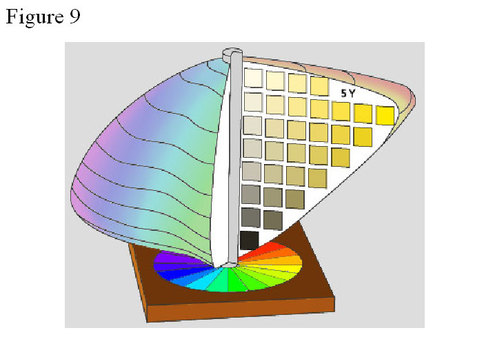
The Munsell system
In this color system, colors are sorted on a cylindrical chart based on three visual attributes:
-
Hue : associated to the common sense of “color” : tells whether an object is rather red, green, blue...
-
Chroma : tells whether the color is pure or conversely close to white (“washed out” or pastel).
-
Value (lightness): an intensity parameter, tells whether the color is dark or bright.
The Munsell system can be represented under the form of a 3-D atlas made up of chips with given values of hue, chroma and value (cf. figure 9)

The system is based on 10 hues obtained from the 5 “elementary hues” : B(blue), G(green), Y(yellow), R(red), P(purple). The 10 hues are given by 2 letters (out of the 5 elementary hues), given in this order , with a “5” before to specify that the color is pure, that is: 5B, 5BG, 5G, 5GY, 5Y, 5YR, 5R, 5RP, 5P, 5PB. These hues are divided in 40 evenly-spaced sub-steps (secondary hues). For instance one may go from yellow to red through the following shades: 5Y, 2.5Y, 10YR, 7.5YR, 5YR, 2.5YR, 10R, 7.5R, 5R. The shade 7.5YR is yellower than 5YR and is located at 2.5 steps from the orange shade 5YR and at 7.5 steps from the yellow 5Y: it corresponds to a “yellowish orange” shade.
Value is plotted on a numerical axial scale consistent with the eye's subjective perception of value, going from 0 for black to 10 for white. Chroma is plotted along a numerical radial scale which is also divided in evenly-spaced steps representing the visual perception of “equal chroma steps” between colors. The Munsell book of colors, realized under the form of a collection of colored samples in 1915, has been corrected in 1943 [] in order to be consistent with the international system CIE 1931. Since that time, the Munsell atlas is named the Munsell renotation system.